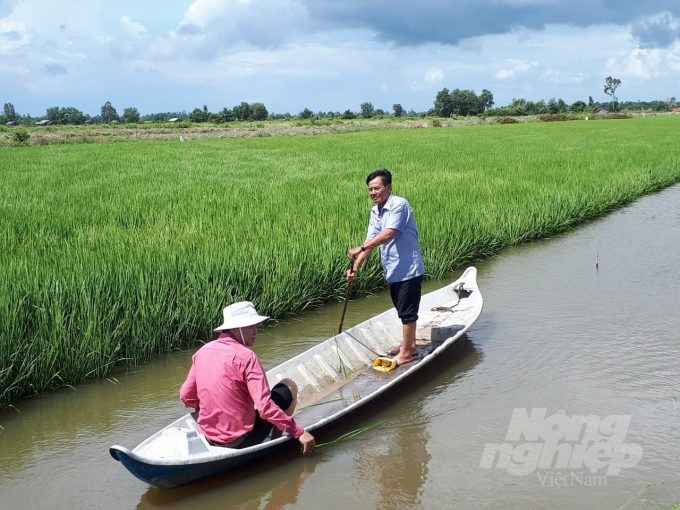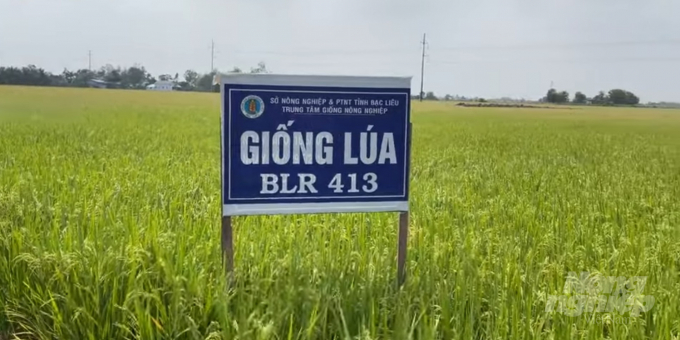November 23, 2025 | 18:35 GMT +7
November 23, 2025 | 18:35 GMT +7
Hotline: 0913.378.918
November 23, 2025 | 18:35 GMT +7
Hotline: 0913.378.918

The rice-shrimp model is currently evaluated as a sustainable and favorable model. Photo: TL.
Mr. Nguyen Phuong Hung, Director Bac Lieu Agricultural Breed Center said that the Agricultural Breed Center for a long time has successfully crossed many rice varieties such as BLR103, BLR105, BLR203, BLR312, BLR413, and BLR404. Through the demonstration production model of these rice varieties at different locations, each rice variety has different adaptation conditions for each ecological region: less infected with brown planthopper, yellow dwarf disease, blast disease, etc.
The center has implemented trial production of three rice varieties BLR103, BLR105 and BLR413 in different ecological zones of the province to further assess their adaptability to serve as the basis for the variety recognition at a national level.
To be more specific, the biological characteristics of these rice varieties are quite prominent in terms of growth time compared to their parent varieties. The stem is hard and short, which has overcome the disadvantage of the parent rice stem being too long and falling easily. The yield is quite high from 6 to 7.5 tons/ha when cultivated in the ecological zones.
The center suggested that the Department of Agriculture and Rural Development, the People's Committee of Bac Lieu province create favorable conditions for the unit to put the BLR413 rice variety into production and aim to build this rice variety into a Bac Lieu-branded rice variety.

Rice variety BLR413, showing adaptability to local ecological zones. Photo: TL.
Currently, the prices of fertilizers, pesticides, and other agricultural materials have all increased, so farmers need to fertilize appropriately to reduce production costs.
Sharing this issue with VAN journalists, Mr. Nguyen Phuong Hung, Director of Bac Lieu Province's Agricultural Breed Center said that the price of rice has also fluctuated abnormally in current times.
On the other hand, the price of rice varieties ST24, ST25, Dai Thom 8, OM18 does not show much difference, so people should be careful on their calculation.
While the fluctuation in rice price remains unpredictable, in order to reduce the production cost for farmers:
Firstly, farmers should act in accordance with the recommendations of the Ministry of Agriculture and Rural Development, sowing the appropriate amount of seed from 80-120 kg/ha.
Secondly, farmers need to fertilize in a balanced manner, at the same time put organic fertilizer into production since saving fertilizer is the most effective way to reduce the total used amount.
Thirdly, during the process of using pesticides, it is essential to determine which objects need to be prevented. Farmers at present still produce following the habit of periodically spraying, which is very expensive. People should note that unnecessary or excessive spraying should be minimized.
According to Mr. Hung, in the process of taking care of all stages, farmers should maximize savings and manage rice seasonal crops well to reduce production costs.
“Farmers in Bac Lieu province currently still have the practice of sowing thick seeds, using a lot of fertilizers and pesticides. If you can reduce these three things: seeds, fertilizers and pesticides, there will be fewer pests and diseases, and the cost will be much lower, then rice farmers can finally gain a profit,” said Mr. Hung.
Translated by Samuel Pham
/2025/11/22/4018-4-213342_747.jpg)
(VAN) The Mekong Delta Agricultural Experts Club has attracted 143 experts and researchers to participate in providing consultancy and contributing initiatives to the development of one million hectares of high-quality rice.

(VAN) Ca Mau’s development of OCOP products opens a path to increasing cooperatives value, helping boost income, expand markets, and affirm collective economy's role.

(VAN) Turning seemingly ordinary coconut shells into unique jewelry and artwork, Nguyen Bang Nhi spreads the value of local culture through her brand, Cocohand.

(VAN) Results from the Sustainable Durian Model Project in Dak Lak have confirmed the critical role of Yara Viet Nam in transferring advanced nutritional solutions to farmers.

(VAN) In Tuyen Quang province, livestock farmers have introduced effective models and innovative practices that significantly strengthen African Swine Fever prevention and control efforts.

(VAN) This is the study conducted by IRRI and Can Tho University on the rice straw value chain in Mekong Delta showing an economic potential of more than 6.6 trillion VND/year.

(VAN) By participating in cooperative economics, many farmers in Tay Ninh have overcome hardship, mastered clean dragon fruit cultivation techniques.